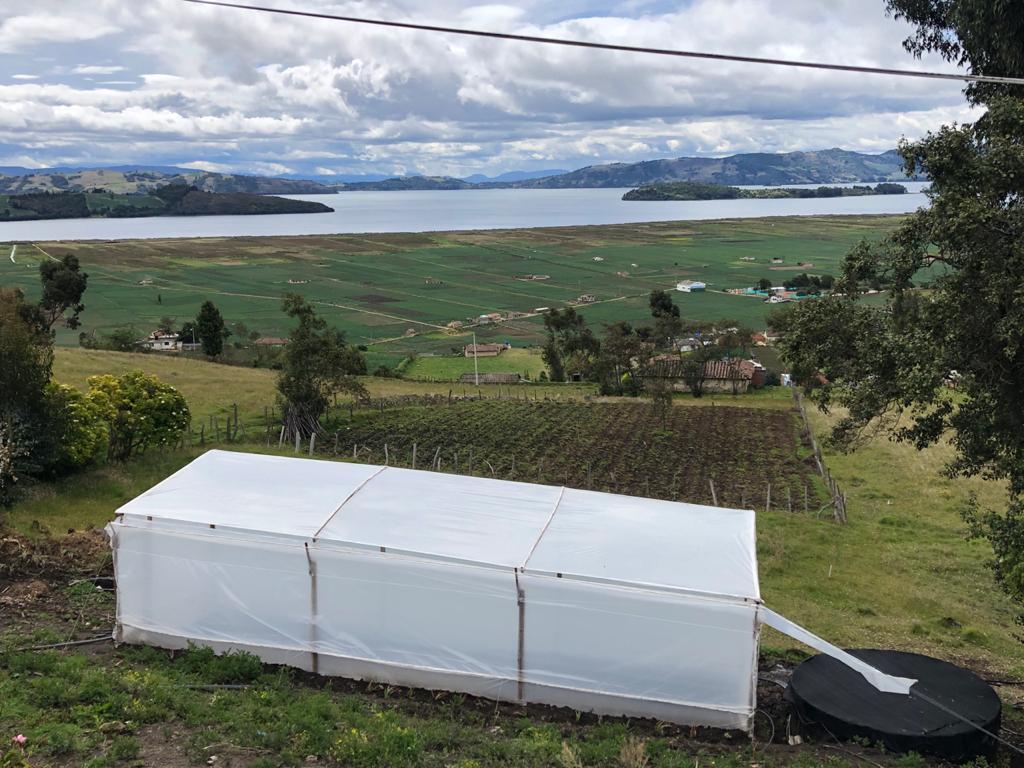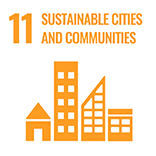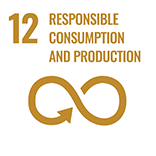Adaptation to the Impacts of Climate Change on Water Resources in the Andes (AICCA), Colombia

Summary
This solution addresses the increasing uncertainty regarding the availability of water resources in the Tota Lake basin, Colombia. It aims to strengthen the resilience of productive systems through rainwater harvesting system.
The effects of climate change, and particularly climate variability during the dry season or days without rain, have been prolonged, resulting in greater uncertainty regarding the availability of water resources. The climate change scenarios for the Lake Tota basin, Colombia, show that for the 2026-2050 period, rainfall could increase by 15-40% in the wet scenario, and decrease by 10-20% in the dry scenario. Regarding average, maximum and minimum temperatures, it was found that all of them could increase in the range of 0.5 to 1°C. Meanwhile, with respect to climate variability, it can be seen that the changes would be increasingly greater: in the projected period, there would be increases of more than 100% in precipitation or reductions of 80% (Armenta Porras, 2019).
Additionally, it is estimated that the agricultural demand of the sub-basins with a very high climate risk oscillates between 37.7 L/s in Quebrada Aguablanca, 33.0 in L/s, Quebrada la Mugre, and 90.5 L/s in the Tobal River (Peña, 2020), all considerably high values when compared to other sub-basins. This situation causes greater uncertainty about the availability of water resources, generating pressure and conflicts for the community to secure it.
These projected intense climate variations, added to the overuse of water, could cause water deficit events, loss of crops, detriment to livelihoods, shortages, economic losses, among others. This implies important challenges in the management and practices of water use, both for productive activities and for domestic use.
Rainwater harvesting is a practice that seeks to collect excess water derived from precipitation and conduct it through channels for its subsequent use (Hirozumi, 2015). To intercept rainwater, available surfaces within a property or farm such as roofs, tiles, sheets and plastic surfaces are usually used. It is estimated that to guarantee the operation of the system, a single or gable roof structure is necessary, with a minimum slope of approximately 3% (Paredes & Sindy, 2019).
Rainwater harvesting systems are mainly made up of the following elements:
- Catchment surface;
- Conduction system;
- Storage tank; and
- Water filter.
These systems vary according to the storage capacity for rainwater harvesting and the needed demand to supply the different activities of the producers or families (Sánchez Rodríguez, 2020). This practice provides water for different uses such as domestic, agricultural and animal consumption, among others. Consequently, the community incurs lower costs for both the collection and transportation of this important resource. Finally, through the implementation of this measure, resilience is generated for families that do not have constant access to water during variability and climate change phenomena, such as droughts or prolonged summer seasons.
In this sense, considering climate change scenarios, an increase in temperature ranging from (0.85 to 0.88 °C) has been identified as a threat in the area where the measure will be implemented, which may eventually cause changes in water availability. Added to this is the fact that in times of drought, various livelihoods of the community of the Tota Lake basin are affected, therefore, rainwater harvesting would increase the adaptive capacity of the community and improve the resilience of agricultural systems since it provides an alternative source of water. The above aims to contribute to reducing the impacts of water shortages, a fundamental resource for the agricultural activity that predominates in the basin.
The objective of this adaptation measure is to strengthen the resilience of productive systems in the Tota Lake basin through rainwater harvesting systems in areas with climatic risks related to changes in water availability.
Additionally, the implementation of the measure is expected to increase the adaptive capacity of communities through capacity building processes for the proper use and management of water, focusing on the response to hydro-meteorological phenomena derived from climate variability and change.
Overview
- Location:
- Implementation sites:
-
- Single country
- Multiple locations
- Mountain region:
-
The Andes
- Province:
-
- Boyacá/Aquitania/ Vereda Hatolaguna, Boyacá/Aquitania/ Vereda Pérez, Boyacá/Aquitania/ Vereda El Tobal, Boyacá/Aquitania/ Head of the municipality
- Site locations:
-
Aquitania
- Solution scale:
- Ecosystem type(s):
- Solution type(s):
- Sector(s):
- Climate impact(s) addressed:
- Other climate impact(s) addressed:
-
- Changes in rainfall patterns, Intense rainfall, Unsustainable use of local resources, Loss of productivity, Crop failure, Reduced water availability, Reduced food security
- Climate impact time-scale(s):
- Main benefit associated with the solution:
- Co-benefit(s) associated with the solution implementation:
- Implementation timeline:
-
- 2021 - 2021
- Sendai targets:
-
Solution details
Main beneficiaries & outcomes
The beneficiaries of the solution are rural women from the municipality of Aquitania, who belong to the Association of Proactive Rural Women of Aquitania (ASOMUC in Spanish). This organization is a key player in the territory as it has experience in the implementation of the initiative to convert crops to good agricultural practices (GAPs). They work in favor of Aquitania women’s rights, food security , and they dream of transforming their environment to ensure a healthier and safer place for their children.
The main benefit associated with the implementation of rainwater harvesting is the reduction of vulnerability in the water resource dimension. With the implementation of this solution, the adaptive capacity of the community is increased and the resilience of agricultural systems is improved, since it establishes an alternative source of water in the face of predominant climate variations that may be accentuated by drought events or intense summers. In addition, it will contribute to reduce the impacts caused by shortages of water, a fundamental resource for agricultural activity, which is the main source of livelihood in the Tota Lake basin.
Co-benefits include:
Social
- Increased resilience of production systems with Good Agricultural Practices.
- Strengthening the technical and organizational capacity of the beneficiaries.
- Strengthening the food security of families.
- Support in the generation of leadership and entrepreneurship skills.
- Recognition of local and ancestral knowledge.
Economic
- Decrease in production losses due to drought seasons.
- Reduction of production costs.
- Support to the family economy of the beneficiaries.
Environmental
- Reduction of water demand in the watercourses surrounding the implementation areas.
- Sustainable water improvement.
The solution is widely available, there are several designs that vary according to the conditions of the property or farm.
Planning and implementation
The planning and implementation process was led by the Adaptation to Climate Change Impacts on Water Resources in the Andes (AICCA) Project, which is financed by the Global Environment Facility (GEF/GEF), implemented by the Development Bank of Latin America (CAF) and executed by the Consortium for the Sustainable Development of the Andean Ecoregion (CONDESAN). In Colombia, the project is being executed jointly with the Ministry of the Environment and Sustainable Development (Minambiente) and the Institute of Hydrology, Meteorology and Environmental Studies (Ideam). The implementation component was coordinated by Luz Ángela Sánchez and her work team.
In a general manner, the methodology for the design and implementation of the rainwater harvesting adaptation measure is described below:
- Socio-environmental diagnosis: an analysis of the territorial context for the relevant aspects of the study area was developed, including the characterization of the main productive systems, ecosystems, actors, level of governance, and agricultural systems with Good Agricultural Practices, among others.
- Development of the Territorial Analysis for Adaptation: the analysis integrated inputs to define the adaptation needs in the territory.
- Beneficiaries selection: a general review of the communities within the properties catalogued with medium and high susceptibility in the previous analysis was carried out, and a survey regarding their roots, vulnerability and dependence was applied to them, which allowed prioritizing the communities that require this type of adaptation measure.
- Design of rainwater harvesting systems. Mapping of ecosystems and land use of the productive system: this input allows identifying the main activities within the property or farm, describing the socio-ecosystems and analyzing the topography. This information enables the identification of problems and limitations with respect to water use and conservation and, in effect, the analysis of alternatives for the design of rainwater harvesting systems (Sánchez Rodríguez, 2020).
-
Construction and implementation. This phase depends on the property and its characteristics. In general, the main actions of this measure are summarized as follows:
- Land preparation and adequacy activities such as grading.
- Installation of catchment systems to take advantage of rainfall runoff.
- Installation of the conduction systems of the water captured by the gutters towards the storage tank.
- Installation of the water conduit from the storage tank to the area where the collected water will be used.
- Training on the correct operation of the harvesting practice.
- Preparation of a maintenance manual for rainwater harvesting systems.
The stakeholders are:
- AICCA Project: leader of the planning and implementation processes for rainwater harvesting systems.
- Autonomous Corporation of Boyacá (Corpoboyacá): technical support for the implementation process of the systems.
- Aquitania Municipal Mayor’s Office: local facilitator and technical support in the implementation process.
- Beneficiary community: participants in the planning, design and implementation of the systems.
Finance
The Project was financed by the Global Environment Facility (GEF/GEF) in the form of grant.
Basic unit: 1 rainwater harvesting system with 5,000 L capacity.
| Main Items | Costs (USD) | Source of information |
|---|---|---|
| Studies | $257.00 | (AICCA,2020) |
| Labor | $117.65 | (AICCA,2020) |
| Inputs and Materials | $882.35 | (AICCA,2020) |
| Training and technical support | $88.23 | (AICCA,2020) |
| Total | $1,345.23 | (AICCA,2020) |
Innovation
The rainwater harvesting adaptation measure focuses on sustainable water use and management. Creating a self-sustainable production system in a context of climate variability and change is one of the main challenges. The implementation process has successfully met this challenge, but various strategies have also been established to strengthen the value chain of the agricultural systems that implement this measure. Particularly, with regard to the strengthening of these actions through green markets and organizational strengthening. The aim is to expand this action into more integrative processes that contribute to the sustainability of the process and, in effect, help to reduce the medium and long-term vulnerability of the beneficiary communities in the context of the global climate crisis.
Performance evaluation
The implementation process is being finalized, so no performance evaluation has been conducted to date.
Long term project sustainability and maintenance
Maintenance activities include:
- Adequacy of gutters
- Hose replacement
- Tank cleaning
Planned for a period of 5 years.
The ASOMUC organization, which is part of the beneficiary community, will be in charge of such activities.
Capacities for design and implementation
Knowledge
Scientific and local knowledge played a decisive role in the solution. For the definition of zones, the following were spatially integrated: climate variability and change scenarios, definition of the Main Ecological Structure (MES), pressures, vulnerability and risk analysis, and hydrological modeling of the Lake Tota basin. This identifies areas with susceptibility for the implementation of adaptation measures in the sectors of natural systems, economic activities and education. Finally, existing and potential adaptation measures were prioritized, according to the effectiveness criteria established by FEBA and subsequently evaluated considering the analysis of gender, actors and conflicts. All the development of these actions was undertaken through local initiatives, highlighting local knowledge, especially in different agricultural practices.
Technology
For the design, the use of Geographic Information Systems (GIS) was fundamental, particularly for the territorial analysis for adaptation.
Political / Legal
The development of this solution was structured within the framework of the National Climate Change Policy, specifically aligned with the strategic line of management and conservation of ecosystems and ecosystem services for low-carbon and climate-resilient development. Moreover, in the framework of the National Adaptation Plan, guidelines were established to address planned adaptation, including: implementing adaptation measures.
Finally, at the local level, the document of the National Council of Economic and Social Policy (CONPES) 3801 from 2014, regulates the environmental management plan for the Lake Tota basin, and within its objectives is that of increasing the development of sustainable productive processes, and the diversification of products in the Lake Tota basin. This national action framework motivated the local teams to develop the solution and facilitated the justification for its development.
Institutional
The local partners for the implementation of the rainwater harvesting measure were the environmental authority, the Boyacá Autonomous Corporation (Corporación Autónoma de Boyacá-Corpoboyacá), and the Aquitania Municipal Mayor’s Office. The coordination mechanism was established through framework agreements for the development of climate change adaptation measures. It defined the commitments of the parties to ensure adequate coordination in the implementation, which has been successful, since it has allowed for adequate coordination with the local community.
Socio-cultural
Within the framework of the project’s governance and sustainability strategy, guidelines were established to create spaces for co-development with the communities and jointly evaluate the main needs related to climate variability and change.
Outlook & Scalability
Barriers and adverse effects
The main barrier for the implementation of the solution was the management of the topography and diverse terrain conditions. Grading actions were carried out to adapt the terrain, and this obstacle was overcome in the implementation process.
Transformation and future outlook
With the development of the solution, impacts related to accentuated climate changes will be faced, increasing the adaptive capacity of the communities and improving their resilience; since with its implementation there is an alternative source of water for different uses, as well as the possibility of storing it in the event of drought or water shortages, accentuated by climate variability and change phenomena. It is a highly viable measure in mountain ecosystems since the slope favors the amount of water that could be collected.
Potential for upscaling and replication
It is desirable to expand the solution given that an increase in temperature is expected worldwide, which may cause strong impacts on water availability, especially in vulnerable populations. With the implementation of this solution, water use is improved and conflicts over water use are reduced.





Comments
There is no content